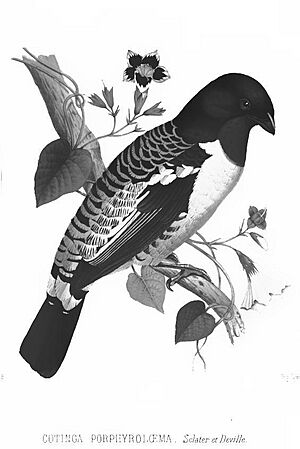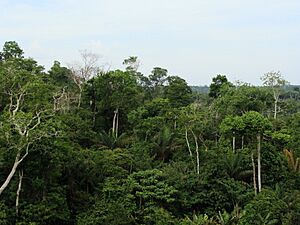Purple-throated cotinga facts for kids
Quick facts for kids Purple-throated cotinga |
|
|---|---|
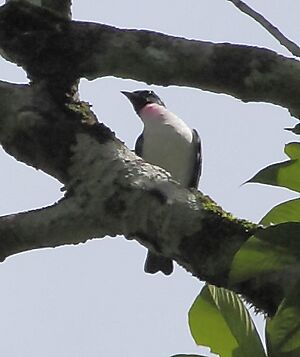 |
|
| Male at Apiacás, State of Mato Grosso, Brazil | |
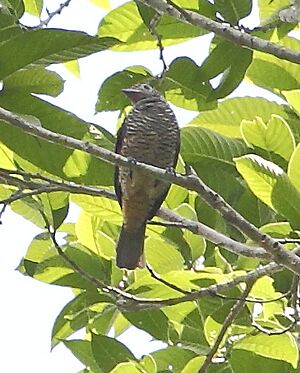 |
|
| Female at the same locality | |
| Conservation status | |
| Scientific classification | |
| Genus: |
Porphyrolaema
|
| Species: |
porphyrolaema
|
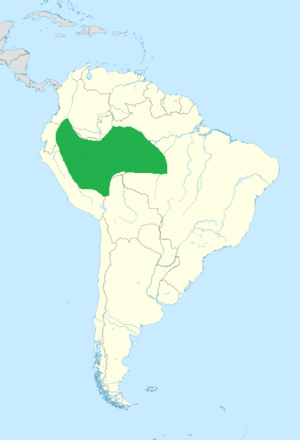 |
|
| Green marking the range of the purple-throated cotinga | |
| Synonyms | |
|
|
The purple-throated cotinga (Porphyrolaema porphyrolaema) is a beautiful bird from the cotinga family. You can find it in the western part of the Amazon rainforest in South America. Its home stretches from southern Colombia, through eastern Ecuador and Peru, and into parts of Bolivia and western Brazil. This bird usually lives high up in the trees of humid forests.
The purple-throated cotinga is the only species in its group, called Porphyrolaema. It's one of the smaller cotinga birds. Males and females look very different, which is called sexual dimorphism. Males have black feathers on top with a bright white stripe on their wings. Their throat is a deep purple, which is how the bird got its name! Females are dark brown with lighter edges on their feathers and a rufous (reddish-brown) throat. Not much is known about this bird, but it mainly eats fruit and sometimes small insects. It's not a migratory bird, meaning it stays in the same area all year. Even though it's not seen very often, it's considered a species of Least Concern, which means it's not currently in danger.
Contents
What is a Purple-throated Cotinga?
The purple-throated cotinga was first described in 1852 by two scientists, Emile Deville and Philip Sclater. They first called it Cotinga porphyrolaema. Just two years later, another scientist, Charles Lucien Bonaparte, decided it was unique enough to have its own group, or genus, called Porphyrolaema. The name porphyrolaema comes from ancient Greek words meaning "dark purple" and "throat," perfectly describing the male bird.
How is it Related to Other Birds?
Even though it was once grouped with other Cotinga species, the purple-throated cotinga has some special features. It has a thicker, shorter beak, unique pale edges on its back feathers, and a square-shaped tail. Recent studies looking at its DNA suggest it might be more closely related to other cotingas that live in the forest canopy. These include the neotropical bellbirds and other cotinga types. This bird does not have any known subspecies, meaning there are no different varieties of it.
What Does the Purple-throated Cotinga Look Like?
Male and female purple-throated cotingas look quite different from each other. This is a common trait in many bird species.
Male Purple-throated Cotinga Appearance
The male cotinga has shiny black feathers on its head, wings, and tail. The feathers on its back and upper wings have white edges, making them look a bit like scales. It also has a clear white stripe on its wings and white edges on some of its flight feathers. The most striking feature is its deep purple throat. Its belly is white, with some black stripes on its lower sides.
Female and Young Purple-throated Cotinga Appearance
The female purple-throated cotinga is mostly dark brown. Her feathers have pale, buffy (light yellowish-brown) edges on her upper body. Her underside is a buffy cinnamon color with black stripes. Her throat is a reddish-brown color without any stripes. Female tail feathers are a bit longer and more pointed than the males'. Young cotingas look like a lighter, more buffy version of the female.
Size and Voice of the Cotinga
Adult purple-throated cotingas are about 16.5 to 18.5 centimeters (6.5 to 7.3 inches) long. They weigh about 49 to 60 grams (1.7 to 2.1 ounces). Males are usually a tiny bit smaller than females. This bird has a wide beak with a strong curve. Its eyes are dark brown, and its beak and legs are black.
Unlike some other cotinga species that are mostly quiet, the purple-throated cotinga has a powerful voice. The male's call is a high, sad-sounding "preeeeeer." It lasts for one or two seconds and drops in pitch. The male repeats this call regularly from a high perch in a tree. It also makes a shaky "werleeyooo" sound sometimes.
Where Does the Purple-throated Cotinga Live?
The purple-throated cotinga lives across a large area of western Amazonia. You can find it from southern Colombia, south through eastern Ecuador and Peru, and into parts of northwestern Bolivia and western Brazil. Its total home range covers about 2,190,000 square kilometers (846,000 square miles). Even though its range is huge, the birds are spread out and not found in large numbers in any one spot. For example, in southeastern Peru, only about two birds were found per 100 hectares (247 acres).
What is the Cotinga's Habitat Like?
This cotinga lives in the tops of trees or along the edges of humid forests. It can be found up to 900 meters (2,950 feet) high, but it mostly prefers humid forests below 400 meters (1,300 feet). It lives in forests that don't flood, or in várzea forests, which are forests that flood seasonally. As mentioned before, it does not migrate, so it stays in its habitat all year long.
Ecology and Behavior of the Cotinga
The purple-throated cotinga mainly eats fruit from forest trees, especially those from the Cecropia genus. It also eats small invertebrates, like insects, sometimes. In some areas, it might move around a bit to find trees that are currently producing fruit. These cotingas are also known to join groups of other fruit-eating birds, like other cotingas and toucans. When they eat, they usually lean down from their perch to pick fruit off a tree in the forest canopy. Unlike many other cotingas, these birds are often seen in pairs. They also like to perch in the canopy to soak up the morning sun.
Reproduction and Life Cycle
A male purple-throated cotinga attracts a female by perching high above the trees. He lets the sunlight shine on his colorful, iridescent feathers to show them off. Scientists don't know much about how these birds breed. However, because they seem to molt (shed feathers) at different times, it's thought they might breed all year long. Only one nest has ever been observed. It was found in December 1997, about 20 meters (65 feet) above the ground in a tree. The nest was placed in the shade to protect it from the sun. Only the female was seen sitting on the nest, but the male was often nearby, possibly watching for danger.
Conservation Status of the Purple-throated Cotinga
The purple-throated cotinga is not a very well-known bird. It seems to be naturally uncommon or rare across its wide range. However, it might be seen less often because it lives high in the tree canopy, making it hard to spot. The IUCN (International Union for Conservation of Nature) lists this species as a species of Least Concern. This is partly because it lives in such a large area. While the IUCN hasn't counted the exact number of birds, they believe the population is decreasing due to forests being cut down.
Images for kids



